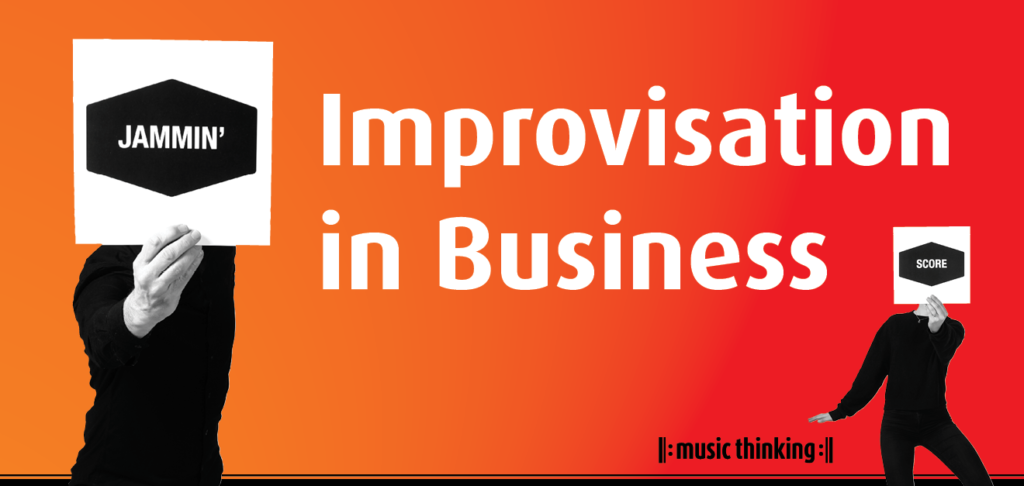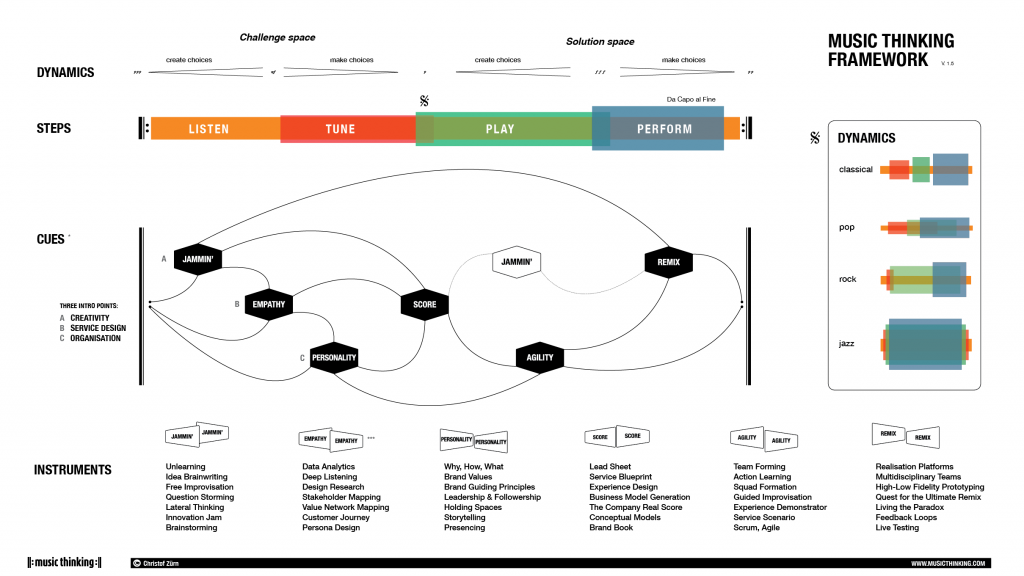
Many people say that our times are volatile, uncertain, complex and ambiguous – some people call it the VUCA times. When making plans they try to execute them until reality comes into play. As a result, they try to quick fix everything as long as possible. Some people call this improvisation.
But improvisation is much more than just a repair mode. Improvisation can also be the start of the creative or change process to design for the VUCA times.
Improvisation in Music
All over the world musicians use improvisation from Indian classical music to Jazz. In music, there are many examples of how improvisation was the start of exceptional work. Johan Sebastian Bach, for example, was a formidable organ improviser. He used improvisation to shape his agility and often put this experience and results in a composition. It was part of his creative process. Ludwig van Beethoven’s 3rd Symphony the ‘Eroica’ – a contest between reason and emotion – finds its start at an improvisation battle. Another example is Giacinto Scelsi. He improvised on the piano and gave the recordings to a transcriber that set it into music. Later he changed the transcriptions to the final score.
Let’s not talk solely about improvisation in music but improvisation in business. The principles of improvisation can be applied to the business world to cope with volatility, uncertainty, complexity and ambiguity.
Improvisation in Business
The Danube University Krems (Austria) Professor for Innovation and Business Lukas Zenk initiated, led and organised a one week course on business improvisation:
We live in a world that is currently undergoing major changes. Many of our previous plans can no longer continue in this form and we are faced with the challenge of acting in the here and now. Improvisation means dealing with the unforeseen (“improvisus” – the unforeseen). In this course, international experts from the arts, science, and business will conduct highly interactive online sessions to teach you the mindset and methods for professional improvisation. The basis of improvisation is found in the arts (theatre, music), however, in Business Improvisation it is applied for entrepreneurial purposes to be prepared for the unexpected.
Professor Wolfgang Stark (University Essen, Strascheg Center for Entrepreneurship) invited Lutz Hempel (Groovin’ Organization) and Christof Zürn to a 3-hour interactive lecture concert. An experiment in Zoom for 16 participants from various companies. Here is the introductory video with a very short glimpse of the first musical interaction.
Interesting links:
Website of the Business Improvisation Course. Prepared for the unexpected
May 25-29, 2020.
Keeping Score – Ludwig van Beethoven: Eroica
Three ways to improvise and play with the Jam Cards
Improvisation in the Music Thinking Framework
In the Music Thinking Framework, improvisation relates to JAMMIN” (one of the six cues).
JAMMIN’ is a very special cue because it is the only cue that appears on two different places in the framework: firstly, before SCORE in the challenge space and secondly, after SCORE in the solution space.

Before SCORE
This means that ‘before SCORE’, JAMMIN’ connects with EMPATHY and PERSONALITY with the function to ‘to open up’ and ‘to sense’ new possibilities. This is comparable with improvisation as mentioned above in the examples of Beethoven and Scelsi.
Translated to a business context it means to use improvisation to sense and trying to understand the future possibilities that can emerge in relation to your audience and the environment (EMPATHY) and you as a brand and the how and why you are (PERSONALITY).
After SCORE
When JAMMIN’ appears ‘after SCORE’ it triggers the functions to ‘explore’ and ‘to create’. Meaning the SCORE gives direction to JAMMIN’.
This is comparable with improvisation like in traditional jazz were improvisation is following given material. This means, for example, a lead sheet with chord symbols and a simple melodic line with a lot of freedom for the soloist.
But if the SCORE is more determined like in a classical music score with many details, then we can talk more about the interpretation of the score than to improvise on the score. So in the classical context that would need the coaching, inspiration and vision of a conductor to bring the intention of the composer of the SCORE to a great performance.
Translated to a business context this all means that we need a common understanding of what a score is or better what kind of score is needed to bring the challenge to a solution. The cue SCORE has two sides as well. Firstly, at the end of the challenge space, the score has the function of ‘to show’, meaning to communicate what everybody should see. Secondly, in the solution space, we need the other function, namely ‘to do’ to help everybody in the organisation to be clear about what everybody should and can do.
Practical workshop
If you are interested in how you can apply music thinking and improvisation business you might be interested in a practical workshop to experience how you can use this for your personal challenges.
What participants have said about the workshop:
A great experience – great speakers.
Compliments to the lecturers who cast a spell over the group.
Also for “non-musicians” totally easy to participate and great links to everyday life.
A lot of knowledge through very little theory.
If this is interesting for you, your team or organisation please contact us for a personal intake.
You might also find inspiration in our detailed offering on workshops, training and programmes.
